
I'd been living in the US for years before I went to a sugar house. I'd vaguely heard of them, but didn't really know what they were. Finally, I was visiting a friend in northern Vermont and she took me to a sugar house near her home. Some sugar houses are not open to visitors, but many encourage them, indeed depending on them for much of their business. The one I visited in Vermont had a store attached where you could buy all kinds of Vermont souvenirs, especially ones that were maple syrup related. Others have restaurants where you can buy pancakes or waffles served with, of course, real maple syrup. Some have both. The one we visited last week had a restaurant, and they sell jugs of syrup. The one we visited this week has a restaurant, and a store. They were offering (ok, charging extra for) rides on a horse-drawn wagon and they have a small petting zoo of farm animals. In the summer they sell homemade ice cream. I doubt if anyone makes a living producing maple syrup alone.
Basically, the sugar house is where they boil the sap they have tapped from maple trees, and boil it, and boil it (hence the steam) . . . until it turns into maple syrup. The evaporators are often (but not always) powered by a wood fire, so there is smoke coming out of the chimney as well as steam. I have now learned to tell if our local sugar houses are boiling or not by looking to see if there is smoke as well as steam. Most people just look for the steam, but sometimes the sugar house will run out of sap if the temperatures are not right for the sap to run well, and then the touristy places will just boil water so it looks as though they are boiling sap. Part of the pleasure for me is walking into the evaporator room and being able to smell the syrup in the air, so I am always disappointed if they are just boiling water!
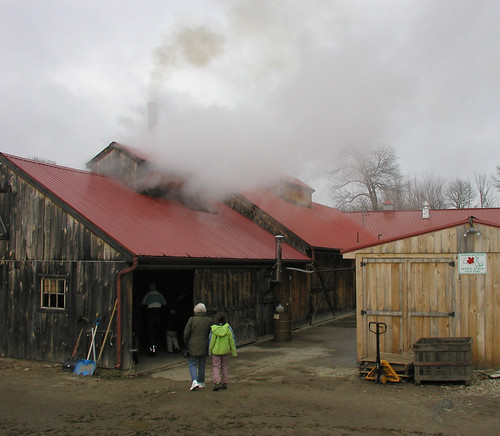
On my first visit to a sugar house, I really didn't know what to expect and was really surprised to find that they were serving small cups of warm maple syrup right from the evaporator!
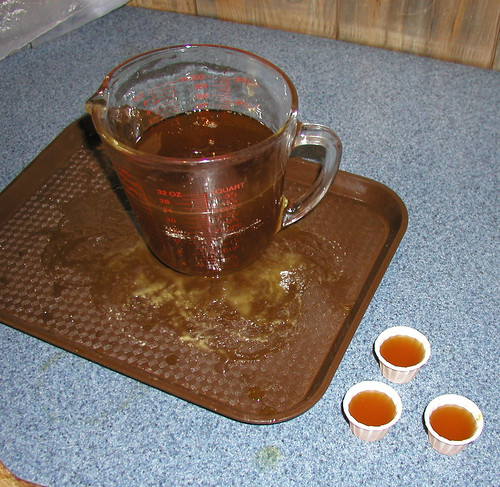
I had had syrup on pancakes before, and just didn't find the idea of drinking that sticky stuff terribly appealing. I failed to factor in a couple of things though:
- Firstly, I don't think I had ever actually had REAL maple syrup before. It is NOT the same as the maple syrup flavoured brown sticky stuff that many places serve with pancakes. Most brands of 'pancake syrup' contain precisely 0% maple syrup. Some might contain as much as 2%! You'll know if it's the real thing though - it will (of course) say so on the bottle, and the price will make you wonder whether it's worth it. If you're still wondering, don't. Just buy it! It is worth it!
- Secondly, the stuff they were serving was warm and runny, not thick and sticky as I had imagined it would be. Fortunately my friend persuaded me to try it - MMMM, was it good!!!!! Somehow, it was slightly buttery and definitely moreish. We circled the evaporator a couple of times and persuaded my friend's DH to take a couple of cups of syrup that he didn't really want so we could have more! This weekend I set a good example to the kids and we only had one sample each.
The native Americans were tapping maple trees and making syrup before the Europeans got here. Their methods were much more intensive though. Rather than boiling the sap, the native Americans dropped hot rocks into the sap to get rid of some of the water! Given that it takes 40 gallons of sap to make one gallon of maple syrup, I would guess it either took them a really long time, or what they ended up with was very different from today's maple syrup.
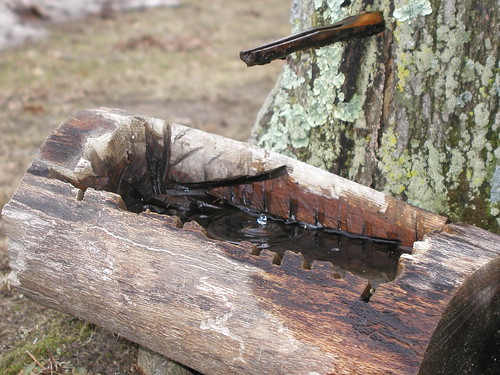
After the Europeans learned the technique from the native Americans, they switched to using wooden buckets.
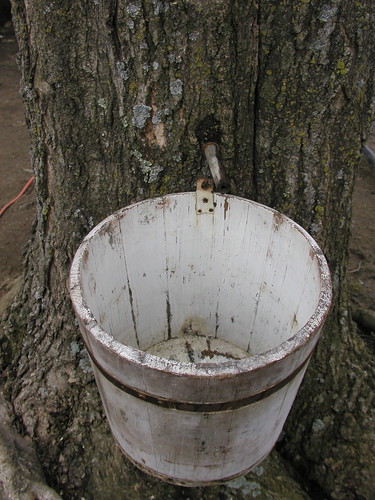
Later they switched to metal buckets and taps as the wooden ones tended to leak. (The buckets usually have lids on them to keep debris out, but the lid had blown off the one in the photo below.)
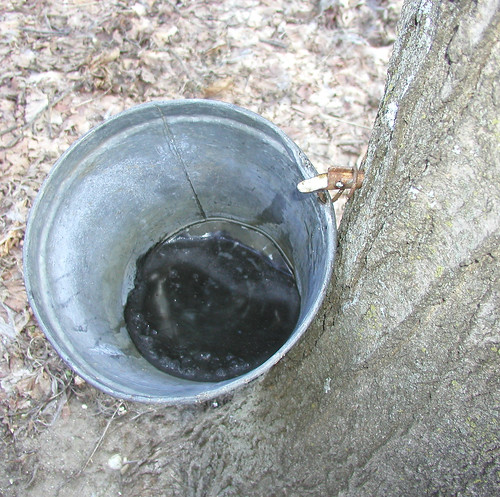
The metal buckets are obviously very labor-intensive to empty, so there is now a more modern way of collecting sap from the trees. In an area where there are lots of trees, there are often trees that look as though they're hooked up to life-support with a series of tubes coming out of them. The tubing runs from one tree to the next, carrying the sap downhill to a collection tank, often situated next to the road.
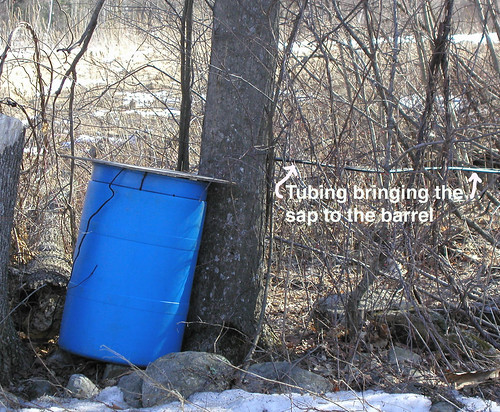
The farmer then pumps the sap from the collection tanks into a larger container on the back of his truck to get it back to the sugar house. The buckets still feature prominently near many sugar houses though as a form of advertising, and on smaller properties where it's not worth running the tubing. Some people who have a bunch of maple trees on their property will have a farmer tap them, and in return they get a portion of the syrup that is generated from the sap from their trees. That would be cool - to have enough maple trees of our own that we could have someone make syrup for us!

Making maple syrup is not something you want to try at home. People I know who have tried it had to redecorate afterwards. By definition, it requires the production of large quantities of steam, and turning your house into a sauna when it was not designed to be one is really Not A Good Thing! (Note the large vents in the roofs of the sugar houses - they are there for a practical reason!)
The photos are all links to Flickr, where they are posted with more comments.




9 comments:
In the "Don't try this at home" department, it's OK to boil sap at home - just don't do it indoors.
I've heard several stories of misadventure of various kinds when trying to boil sap in the kitchen.
One misadventure seems to be fairly common. Boiling a large amount of sap and peeling all the wallpaper in the room off the wall.
Another one that I only heard of recently is the deposit of airborne syrup from the boiling process on the walls. The victims apparently spent the next week cleaning the kitchen walls for the host's wife.
Traditionally, before sugar houses, the sap was boiled outdoors in huge kettles over open fires. Best to try OUTSIDE! Less to clean!
>>> Don't try this at home>>>
Reminds me of an acquaintance who decided to make their own toffee apples for Halloween....boiling sugar for toffee required more skill than they possessed.
First pan of useless runny stuff got poured into the cracks on the patio, as did the second and then the third...they had the sweetest patio in the village.
Within a few days the local ants moved into this sweety heaven and it took weeks to de-infest the house!
Reluctant to admit defeat, they persevered, and did eventually crack the hard toffee recipe, but chose the next year to buy ready made toffee apples from the store.
Todays question...how does one (ethically) dispose of useless runny syrup?
Coo - thanks for that. I can't believe how much I'm still learning after 18 years here!
That was really interesting. I like 'maple syrup' but doubt whether I've every tasted the real thing.
Great post. I think you're right, my aversion to maple syrup probably stems from me never having tried the good stuff. I'm up for trying a sugar house any day. Just the name sounds wonderful!
Thanks I really enjoyed this post. The process is really interesting and I'd forgotten about maple syrup (being British where it's not a regular thing as you know)...you've inspired me to go out and buy some.
I went with my oldest daughter when she was five to see how maple syrup was made. It was in Ohio and we had a great time.
It is true that the syrup is different when it is not factory produced.
I miss maple syrup sausages which I cannot find here in Europe.
And, I miss the maple tree which is just beautiful.
Hey! I went to that same Sugar Shack this year for pancakes.
I even went in the pen to pet the goats.
Post a Comment